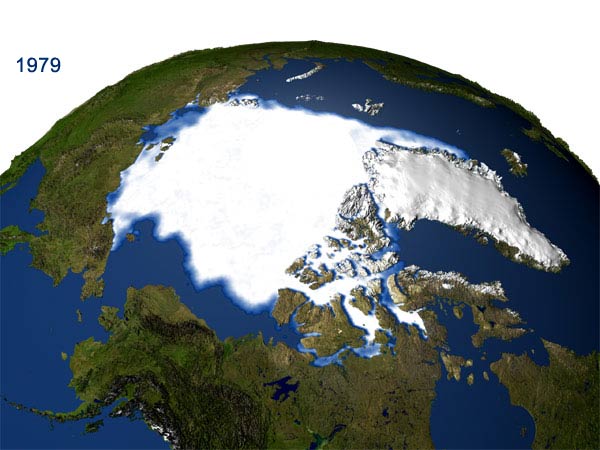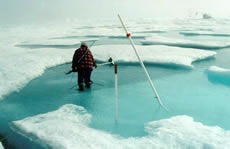Feedback
Melting Icecaps: Positive Feedback
Positive feedback makes things very difficult to predict! Linear systems are easy to predict, but feedback makes systems behave nonlinearly
so that a given input does not result in a simple, proportional output.
The melting of the polar icecap provides a powerful example of this phenomenon. Why do we care about melting icecaps? For one thing, melting ice
will result in a rise of global sea levels that could range from centimeters to tens of meters - we just don't know yet - and this could easily
be catastrophic for coastline areas around the globe. For another reason, melting ice will dilute the salinity of the oceans. Even a small change
in saltiness could have a large ripple effect on oceanic ecosystems.

Mouse-over the image to see the reduction in polar sea ice from 1979 to 2003. Images courtesy of NASA.
Let's see how positive feedback is at work in the melting of polar sea ice. The key effect is due to the greater reflectance of ice than liquid water.
When sunlight hits the frozen icecap, most of the enrgy is reflected back into space. However, when sunlight hits a pool of melted water on the icecap,
more of the energy is absorbed (by the darker colored liquid) which is then converted to heat. This warmer water then melts the surrounding ice,
causing the pool of melted water to expand, which then absorbs more sunlight, capturing even more heat, and so on. Image courtesy of the National Snow and Ice Data Center.
"A linear increase in heat in the Arctic Ocean will result in a non-linear, and accelerating, loss of sea ice."
Norbert Untersteiner, Professor Emeritus, University of Washington, July 2006
As an illustration of how quickly things can change when positive feedback loops are involved, consider the following excerpt from a news article in 2007, titled
"Mark Serreze, an Arctic specialist at the US National Snow and Ice Data Centre at Colorado University in Denver, said: "It's amazing.
It's simply fallen off a cliff and we're still losing ice." The Arctic has now lost about a third of its ice since satellite measurements
began thirty years ago, and the rate of loss has accelerated sharply since 2002. Dr Serreze said: "If you asked me a couple of years ago
when the Arctic could lose all of its ice then I would have said 2100, or 2070 maybe. But now I think that 2030 is a reasonable estimate.
It seems that the Arctic is going to be a very different place within our lifetimes, and certainly within our childrens' lifetimes."
And the rate of change appears to be increasing, as evidenced by news stories from 2008 such as this one from the BBC:
'A few years ago, scientists were predicting that Arctic waters would be ice-free in summers by about 2080.
Then computer models started projecting earlier dates, around 2030 to 2050.
Then came the 2007 summer that saw Arctic sea ice shrink to the smallest extent ever recorded, down to 4.2 million sq km from 7.8 million sq km in 1980.
By the end of last year, one research group was forecasting ice-free summers by 2013.
"I think we're going to beat last year's record melt, though I'd love to be wrong," said Dr Stroeve.
"If we do, then I don't think 2013 is far off any more. If what we think is going to happen does happen, then it'll be within a decade anyway." '
|
The 'albedo', or reflectance, of liquid water, ice, and snow-covered ice. Albedo shows the proportion of energy that is reflected. A high
albedo, 0.9, at the bottom, means that only 10% of the sun's energy is absorbed. A low albedo, 0.6, at the top, means that 94% of the solar
energy is absorbed as heat. Image courtesy of the National Snow and Ice Data Center.

Scientist taking measurements in an arctic melt pond. Photo courtesy of Don Perovich, U.S. Army Cold Regions Research and Engineering Laboratory.
|
The point is to appreciate the difficulty of making predictions of complex systems involving feedback loops. Furthermore, we've only looked at one
feedback loop here, involving the reflectance of sea ice. There are many other interacting systems that make accurate predictions even more difficult.
An example of a separate, but interconnected positive feedback loop, involves the melting of the permafrost. As the atmosphere warms, vast regions of
frozen tundra ('permafrost') begin to melt, releasing enormous quantities of methane, which is a potent greenhouse gas. This in turn causes more
heat to be trapped in the atmosphere, further raising atmospheric temperatures, causing more permafrost to melt, etc...
According to the BBC article above, what percentage of the arctic sea ice present in 1980 had survived by 2007? [ ]
|


